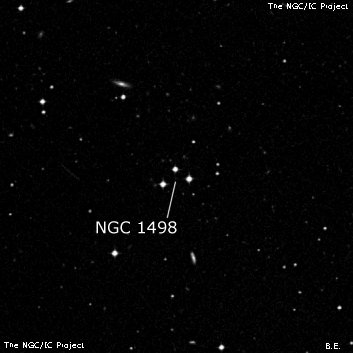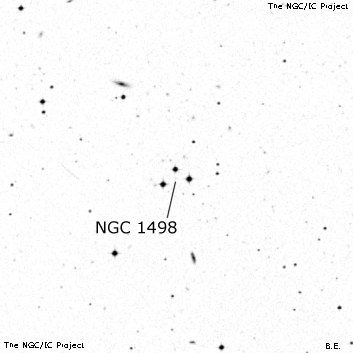NGC/IC Project Restoration Effort
(This is a very very beta version)
NGC1498


Basic Information
Location and Magnitude
Right Ascension: 4:0:19.4
Declination: -12:1:10
Constellation: ERI
Visual Magnitude:
Historic Information
Discoverer: Herschel W.
Year of discovery: 1784
Discovery aperture: 18.7
Observational
Summary description: Cl, S, C
Sub-type: *3
Corwin's Notes
=====
NGC 1498 is probably the triangle of three stars centered about 2 arcmin west
of the NGC position. Curiously, WH's original observation reduces to a
position 34 seconds of time on further west (there is nothing in that field
but a few 18th magnitude galaxies). The NGC position comes from GC; did CH
make an error in her reduction of her brother's observations or did JH somehow
miscopy his aunt's MS? Or did they have access to other information in the
sweep that led them to change the position? GC has no notes on the object,
and Dreyer's 1912 note to WH's observation, "There is no very pronounced
cluster near the place," is not very informative even if it is accurate. The
only other historical evidence comes from Auwers's reduction: he gets the
same answer I do, 34 seconds west of the NGC position.
Assuming that the asterism is indeed the object that WH saw, we now find it
about 40 arcsec across, and matching WH's description pretty well. Could he
have glimpsed some of the much fainter stars in the field as well? They might
add a "depth" to the asterism that would make it appear to stand out even
more from the surrounding field and take on the appearance of a richer
cluster.
Steve's Notes
=====
NGC 1498
17.5" (12/30/99): at 220x, this is an easily resolved trio of mag 13.5-14 stars forming a small isosceles triangle (separations of 30", 30", 45"). This triple star or asterism is the closest object to William Herschel's position but it's difficult to see how he confused it with a poor cluster.



